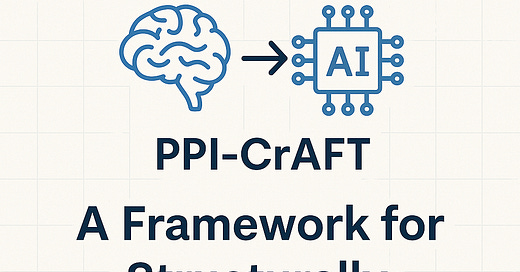🧠 Announcing PPI-CrAFT: A Framework for Structurally Guided AI Creativity
📌 Creativity should not be stochastic noise. It should be traceable, testable, and reversible.
I’m excited to share that my latest research paper,
“PPI-CrAFT: Structurally Constrained Creativity in Generative AI via Predictable Intervention,”
is now published as a preprint on Zenodo:
👉 Read the full paper here (DOI: 10.5281/zenodo.15924263)
🔧 What Is PPI-CrAFT?
PPI-CrAFT is a new AI architecture that formalizes creativity as a structured process of epistemic migration—from uncertain hypotheses to validated, auditable knowledge.
It is grounded in a foundational design constraint I call the Principle of Predictable Intervention (PPI):
An intelligent system should intervene only where feedback is stable, causal, and verifiable.
Unlike traditional generative systems that treat creativity as fluent synthesis, PPI-CrAFT defines creativity as a disciplined progression across epistemic zones, using structure—not randomness—as the source of innovation.
🧱 The Five Modules of Creativity
PPI-CrAFT is implemented through five tightly integrated modules:
Zone Classifier – Epistemically triages all content into:
Zone A (verified), Zone B (speculative), or Zone C (noise).
Human Intent Injection – Ensures Zone B exploration is domain-informed and ethically bounded.
Controlled Simulation – Gathers structured feedback under defined test conditions.
Migration Evaluation – Promotes hypotheses only after repeatability and traceability are demonstrated.
Knowledge Lock-In – Commits only validated content into core memory, with full audit trail.
This pipeline makes creativity not just possible, but governable.
🧪 Case Study: Creative Governance of a Medical Innovation
The paper includes a simulated application:
How intra-tumoral chlorine dioxide therapy, a controversial cancer treatment hypothesis, could be elevated into a reproducible protocol using the PPI-CrAFT framework.
It illustrates how alternative ideas—initially rejected by institutions—can still follow a structured pathway toward scientific acceptance, if guided by feedback-grounded architecture.
🌐 Applications Beyond AI
PPI-CrAFT is designed as a general-purpose framework for any high-stakes system where innovation must be grounded in feedback. Potential domains include:
Drug discovery – promoting high-risk molecules through structured simulation
Materials science – modeling exotic configurations before lab trials
Education – validating personalized learning strategies
Finance – stress-testing speculative trading models
Policy – simulating radical governance proposals safely
In each domain, PPI-CrAFT offers a repeatable method for transforming uncertainty into insight.
👥 Who This Framework Is For
AI architects designing creativity-aware systems
Systems theorists modeling epistemic transitions
Medical innovators handling high-risk hypotheses
Policy designers seeking structure for experimental reform
Epistemologists exploring feedback-based knowledge structures
📖 Access the Preprint
👉 DOI: https://doi.org/10.5281/zenodo.15924263
📄 Title: PPI-CrAFT: Structurally Constrained Creativity in Generative AI via Predictable Intervention
👤 Author: Xuewu Liu
📬 Contact: liuxuewu@wanbincell.com
💬 Final Words
PPI-CrAFT is not a model. It is a constraint system.
As generative intelligence moves into medicine, governance, and law, we must abandon architectures that confuse speculation with truth. We need systems that can say:
“This is not ready. This is not testable. This should not yet act.”
PPI-CrAFT offers that discipline—not by limiting creativity, but by making it structurally honest.
If you work in systems that intersect with innovation and uncertainty, I invite you to read, share, or collaborate.
— Xuewu Liu




